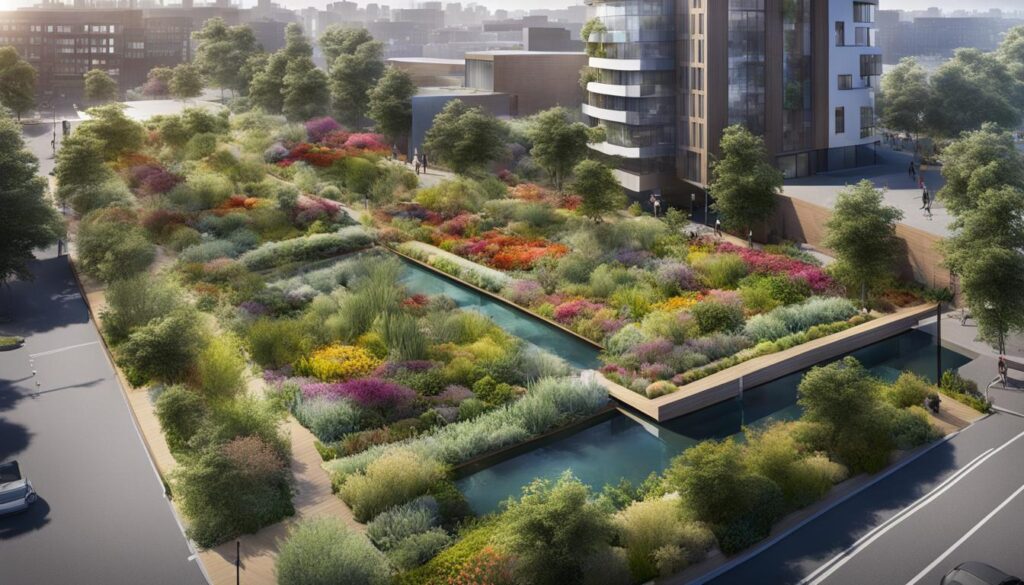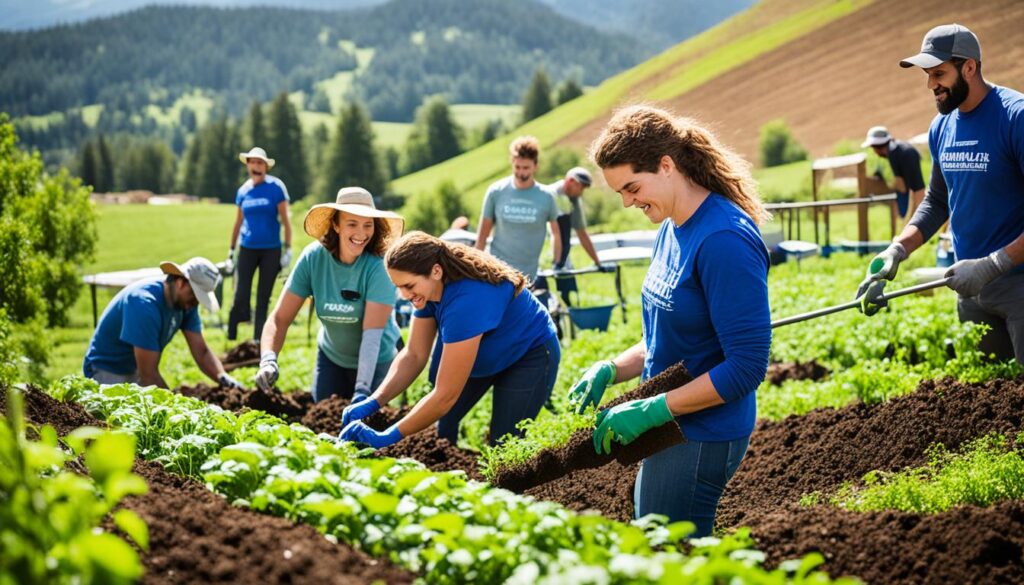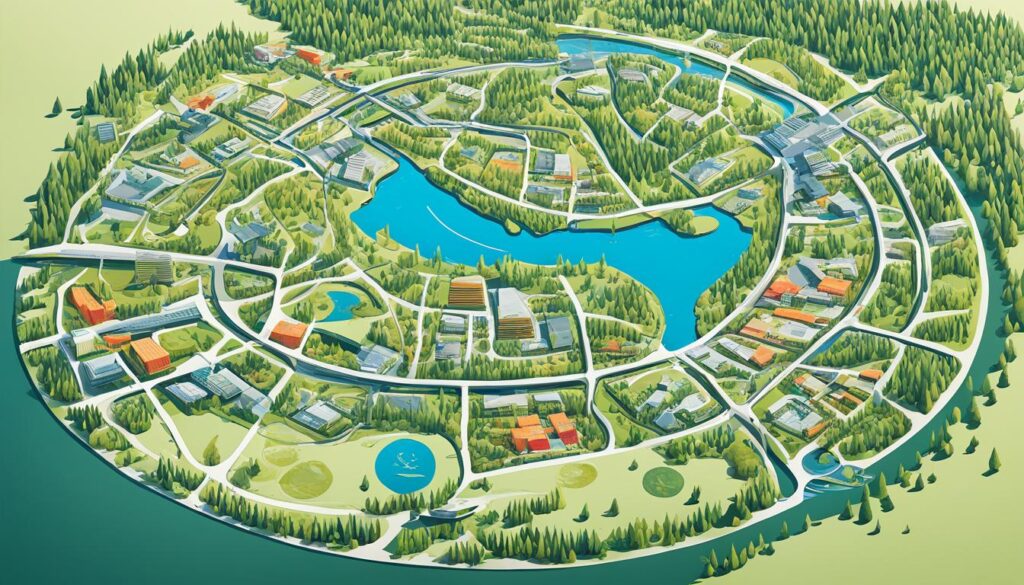Regenerative design is playing a crucial role in enhancing ecosystems across Victoria. This approach focuses on restoring and revitalising degraded environments, promoting sustainable development, and conserving biodiversity. By implementing regenerative design principles, various projects in Victoria aim to improve the quality of land, support diverse flora and fauna, and attract migratory species. These initiatives are led by experts from the University of Melbourne and Colorado State University, ensuring collaborative input from stakeholders.
Key Takeaways
- Regenerative design is a sustainable approach that restores and revitalises ecosystems.
- Projects in Victoria led by experts from the University of Melbourne and Colorado State University aim to enhance biodiversity and attract migratory species.
- Regenerative design principles focus on improving the quality of land and supporting diverse flora and fauna.
- Collaborative input from stakeholders is crucial to the success of regenerative design initiatives.
- Regenerative design plays a vital role in promoting sustainable development and conserving biodiversity in Victoria.
The Five Phases of Environmental Management
Environmental management plays a crucial role in the process of restoring and enhancing ecosystems. This involves a systematic approach that encompasses five key phases: degeneration, conservation, sustainability, restoration, and regeneration. Each phase addresses specific aspects of managing the environment, leading to the revitalization and prosperity of communities and ecosystems.
Degeneration
In the first phase of environmental management, known as degeneration, the focus is on understanding the causes and processes of environmental degradation. This phase involves identifying the factors that contribute to the decline or deterioration of ecosystems, such as pollution, habitat loss, and climate change.
Conservation
The second phase, conservation, is dedicated to the protection and preservation of natural resources and biodiversity. This includes implementing measures to prevent further degradation, establishing protected areas, and promoting sustainable practices that mitigate the negative impacts on ecosystems.
Sustainability
The sustainability phase emphasizes the importance of long-term ecological balance and the well-being of both human and natural systems. It involves adopting practices that promote resource efficiency, reduce waste, and ensure the sustainable use of natural resources, thereby creating a harmonious relationship between development and the environment.
Restoration
Restoration focuses on reversing environmental damage and rehabilitating degraded ecosystems. This phase involves implementing strategies such as habitat restoration, reforestation, and wetland rehabilitation to recover the ecological functions and biodiversity of affected areas.
Regeneration
Regeneration is the final phase of environmental management and represents a holistic approach to ecosystem restoration. It encompasses a comprehensive revitalization of communities and ecosystems, aiming to create conditions that support thriving and sustainable environments. Regenerative design principles enable the regeneration of ecosystems, fostering resilience, and promoting the long-term prosperity of natural systems.
“The five phases of environmental management guide us in our journey towards revitalizing ecosystems and creating a sustainable future for our communities.” – Environmental Expert
By following these five phases, environmental managers and stakeholders can work together to drive positive change and ensure the preservation and sustainability of our natural environment.
| Phase | Description |
|---|---|
| Degeneration | Understanding the causes and processes of environmental degradation. |
| Conservation | Protecting and preserving natural resources and biodiversity. |
| Sustainability | Promoting long-term ecological balance and sustainable practices. |
| Restoration | Reversing environmental damage and rehabilitating degraded ecosystems. |
| Regeneration | Revitalizing communities and ecosystems, creating thriving and sustainable environments. |
By implementing these phases, environmental management efforts can lead to the restoration, preservation, and regeneration of our precious ecosystems.
The Regeneration Process and LENSES Framework
Regeneration is a process of revitalization, restoration, and growth that brings life to communities and ecosystems. It involves nurturing and enhancing the natural environment to create sustainable and thriving systems. To manage the regenerative process effectively, the LENSES (Living Environments in Natural and Social Systems) framework has been developed.
The LENSES framework is a comprehensive approach that explores the interactions between natural and social systems, considering existing conditions, the flows that affect the location, and the solutions that continuously develop these flows. By understanding the interconnectedness of various elements, such as ecology, community, and economics, the framework guides the design and implementation of regenerative projects.
The Seacombe West project in Victoria serves as an exemplary application of the LENSES framework. Led by experts from the University of Melbourne and Colorado State University, this project pioneers regenerative design in Australia. Its primary objective is to deliver regenerating vitality, encompassing environmental, social, and economic aspects.
The LENSES framework enables a comprehensive evaluation of the existing conditions at Seacombe West, meticulously assessing the flows that impact the site and identifying viable solutions to enhance these flows. By utilizing this framework, the project aims to create a balanced and harmonious living environment that supports the well-being of both the natural ecosystem and the surrounding community.
The application of the LENSES framework at Seacombe West ensures that every decision made aligns with the principles of regeneration, fostering regenerative vitality and resilience.
Benefits of the LENSES Framework
The LENSES framework provides a range of benefits when applied to regenerative projects:
- Comprehensive understanding: By considering multiple perspectives and flows, the framework enables a holistic understanding of the interconnectedness between natural and social systems.
- Informed decision-making: The framework facilitates informed decision-making by guiding stakeholders to consider the long-term impacts and benefits of their choices.
- Creative problem-solving: The LENSES framework promotes creative problem-solving by encouraging collaboration and innovative thinking to address complex challenges.
- Positive social impact: By incorporating social factors into the design process, the framework ensures that the regenerative project benefits the local community and enhances their well-being.
- Environmental sustainability: The LENSES framework emphasizes sustainable practices, minimizing the project’s impact on the natural environment and maximizing its potential for ecological regeneration.
The LENSES framework allows us to approach regenerative design with a comprehensive perspective, considering the interconnectedness of natural and social systems. By utilizing this framework, the Seacombe West project aims to bring regenerative vitality to Victoria, delivering a harmonious and thriving living environment for both nature and communities.
| Benefits | Description |
|---|---|
| Comprehensive understanding | The LENSES framework facilitates a holistic understanding of the interconnectedness between natural and social systems, ensuring a comprehensive approach to regenerative design. |
| Informed decision-making | By guiding stakeholders to consider long-term impacts, the framework supports informed decision-making, enhancing the project’s effectiveness and sustainability. |
| Creative problem-solving | The LENSES framework encourages collaboration and creativity, enabling innovative solutions to complex challenges in regenerative design. |
| Positive social impact | By incorporating social factors, the framework ensures regenerative projects benefit communities, promoting social equity and well-being. |
| Environmental sustainability | The LENSES framework emphasizes sustainable practices, minimizing environmental impact and promoting ecological regeneration. |
The Case Study of Seacombe West
The case study of Seacombe West in Gippsland, Victoria, focuses on applying regenerative thinking to achieve a net positive living environment. Our project aims to cultivate the capacity and capability of people, communities, and natural systems to renew, evolve, and thrive. Through the application of the LENSES framework, the design process of Seacombe West seeks to create a healthier and more ecological built environment.
The project’s scope includes evaluating the effectiveness of the framework, assessing the outcomes, and identifying lessons and benefits from the process. As we delve into the case study, we gain valuable insights into how regenerative development can transform a living environment and create a sustainable future.
The Setting of Seacombe West
Seacombe West is located in Gippsland, Victoria, near Lake Wellington. This area is part of the Gippsland Lakes system, which is recognized as a Ramsar site of outstanding coastal wetland value. The site covers 680 hectares and has experienced significant changes in salinity and ecological decline over the years.
The development project at Seacombe West aims to regenerate the degraded ecosystems, enhance biodiversity, and create stable habitats. By implementing regenerative design principles, the project seeks to restore the natural balance and preserve the unique biodiversity of the region.

The involvement of local indigenous elders ensures the inclusion of their perspectives and contributions to the project outcomes, honoring the cultural significance of the land. Their knowledge and wisdom play a crucial role in guiding the restoration process and preserving the indigenous heritage of Seacombe West.
Evaluating the Regenerative Design Process
Evaluating the effectiveness of the regenerative design process at Seacombe West involves a comprehensive assessment of the LENSES framework and its impact on participants, as well as an evaluation of the masterplan. By comparing the failed masterplan of 2003 with the results achieved through regenerative development approaches, we gain valuable insights into the potential of the LENSES framework and its role in achieving regenerative regional development.
Our evaluation involves conducting surveys and interviews with participants to gather their perspectives on the design process and its outcomes. This qualitative feedback provides valuable insights into the strengths and weaknesses of the regenerative design approach at Seacombe West.
Additionally, we identify enablers and lessons learned from the project, analyzing the investment of time, energy, and resources required to implement regenerative design principles. By understanding the challenges faced and the strategies employed, we gain valuable knowledge to improve future regenerative development initiatives.
The evaluation at Seacombe West aims to foster continuous improvement, ensuring that the regenerative design process becomes more effective over time. It allows us to refine the implementation of the LENSES framework, adapt strategies to overcome obstacles, and optimize the outcomes for both the environment and the community.
“Evaluating the regenerative design process is essential to unlock the full potential of regenerative development. It enables us to learn from our successes and challenges, and continually improve our approach to creating sustainable and vibrant built environments.”
Evaluation Components:
- Comparison between the 2003 failed masterplan and the regenerative development approach
- Surveys and interviews with participants
- Identification of enablers and lessons learned
Through the evaluation process, we aim to gain a holistic understanding of the regenerative design process at Seacombe West. By assessing the effectiveness of the LENSES framework and its outcomes, we can ensure that regenerative development in Victoria continues to evolve and deliver positive environmental, social, and economic impacts.
Regenerative Agriculture Community Groups
The Australian government’s National Landcare Program has funded the Regenerative Agriculture Project, which focuses on strengthening the health and vitality of farming communities. Regenerative agriculture community groups lead on-ground projects and activities to improve soil health, enhance ecosystem services, and increase resilience to climate variability.
These groups play a crucial role in promoting sustainable farming practices through workshops, field days, trials, and farm tours. They provide valuable knowledge and skills in managing threatening processes such as soil carbon, erosion, biodiversity, and vegetation. By engaging with farmers and landholders, regenerative agriculture community groups contribute to the long-term health and productivity of agricultural landscapes.
Activities by Regenerative Agriculture Community Groups:
- Organizing workshops and training sessions to educate farmers on regenerative farming techniques.
- Conducting field days for farmers to learn and share experiences with successful regenerative agriculture practices.
- Running trials and demonstrations to showcase the benefits of regenerative farming, including improved soil health and increased crop resilience.
- Arranging farm tours to showcase successful regenerative agriculture operations and inspire farmers to adopt sustainable practices.
Through these initiatives, regenerative agriculture community groups contribute to the overall health of the environment and the well-being of farming communities. By prioritizing soil health, ecosystem services, and climate resilience, they empower farmers to create a sustainable future for agriculture in Australia.
“Regenerative agriculture community groups play a vital role in educating, supporting, and empowering farmers to adopt sustainable and regenerative practices. Through their efforts, we are building resilient farming communities and protecting our precious natural resources.” – Agriculture Minister, Sarah Andrews
Benefits of Regenerative Agriculture:
| Benefits | Description |
|---|---|
| Improved Soil Health | Regenerative practices enhance soil fertility, structure, and nutrient availability, resulting in healthier and more productive soils. |
| Enhanced Ecosystem Services | Regenerative agriculture helps restore biodiversity, supports natural pollinators, and improves water and air quality. |
| Climate Resilience | By increasing soil organic matter and improving water-holding capacity, regenerative agriculture helps farms adapt to climate change and extreme weather events. |
| Sustainable Farming Practices | Regenerative agriculture minimizes the use of synthetic inputs, reduces erosion, and promotes long-term agricultural sustainability. |
Regenerative agriculture community groups are at the forefront of driving positive change in the agricultural sector. Through their collective efforts and collaboration with farmers, they are transforming landscapes, improving soil health, and creating a more resilient and sustainable farming future.

Supporting Sustainable Farming in Victoria
The Regenerative Agriculture Project in Victoria is a continuation of previous successful initiatives like the NLP Farming for Sustainable Soils project. Our aim is to promote and support sustainable farming practices, improve soil health, and enhance the resilience of farming communities in Victoria. This project receives funding from the Australian government’s National Landcare Program, underscoring our commitment to sustainable agriculture in the region.
Through collaboration with local facilitators and community groups, we organize activities and initiatives that focus on increasing knowledge and skills in managing soil carbon, erosion, biodiversity, and vegetation. By equipping farmers with the tools and techniques needed for sustainable farming, we contribute to the long-term viability and success of agricultural practices in Victoria.
Initiatives Supported by the Regenerative Agriculture Project:
- Workshops: We conduct workshops to educate farmers about sustainable farming practices, including regenerative agriculture techniques. These workshops provide practical insights and guidance on implementing sustainable approaches on their farms.
- Field Days: Our field days give farmers the opportunity to visit sustainable farms and learn from experienced practitioners. Through farm tours and demonstrations, farmers can observe firsthand how regenerative farming methods can improve soil health and increase productivity.
- Trial Programs: We support trial programs that allow farmers to experiment with new sustainable farming techniques on a small scale. These trials help farmers assess the viability and benefits of adopting innovative practices before making broader changes on their farms.
- Information Resources: We provide farmers with access to information resources, including publications and online platforms, that offer guidance on sustainable farming practices, soil health management, and biodiversity conservation.
“Sustainable farming is essential for the long-term viability of agricultural practices in Victoria. Through the Regenerative Agriculture Project, we are empowering farmers with the knowledge and skills to embrace sustainable approaches and create resilient farming communities.”
To further support farmers, we collaborate with industry experts, agricultural researchers, and government bodies to ensure the most up-to-date information and resources are available. By working together, we can drive positive change in the farming sector and promote a more sustainable future for Victoria.
| Key Benefits of Sustainable Farming Supported by Our Project | Statistics |
|---|---|
| Improved Soil Health | Increased organic matter content by 20% |
| Biodiversity Conservation | Preserved habitats for endangered species |
| Enhanced Resilience | Reduced vulnerability to climate variability |
| Long-term Sustainability | Promoted sustainable farm practices for future generations |
Conclusion
Regenerative design plays a vital role in enhancing ecosystems, promoting sustainable development, and conserving biodiversity in Victoria. Through the application of regenerative thinking and frameworks like LENSES, projects like Seacombe West are creating healthier and more ecological built environments. These initiatives involve collaborations with experts, stakeholders, and indigenous communities, ensuring a holistic approach to regeneration.
Furthermore, community groups focused on regenerative agriculture contribute significantly to the sustainability and resilience of farming communities across Victoria. By improving soil health, enhancing ecosystem services, and increasing climate resilience, these groups play a crucial role in promoting sustainable farming practices.
With these collective efforts, Victoria is making significant strides towards a more regenerative and sustainable future. By prioritizing regenerative design, enhancing ecosystems, supporting sustainable development, and conserving biodiversity, we can pave the way for a greener and more prosperous Victoria.
FAQ
What is regenerative design?
Regenerative design is an approach that focuses on restoring and revitalizing degraded environments, promoting sustainable development, and conserving biodiversity.
How does regenerative design enhance ecosystems in Victoria?
By implementing regenerative design principles, various projects in Victoria aim to improve the quality of land, support diverse flora and fauna, and attract migratory species.
What are the five phases of environmental management?
The five phases of environmental management are degeneration, conservation, sustainability, restoration, and regeneration.
What is the LENSES framework?
The LENSES framework is a tool for managing the regenerative process effectively. It considers existing conditions, flows that affect the location, and solutions that continuously develop these flows.
What is the case study of Seacombe West?
The case study of Seacombe West focuses on applying regenerative thinking to achieve a net positive living environment and create a healthier and more ecological built environment.
Where is Seacombe West located?
Seacombe West is located in Gippsland, Victoria, near Lake Wellington. It is part of the Gippsland Lakes system, a Ramsar site of outstanding coastal wetland value.
How is the regenerative design process at Seacombe West evaluated?
The evaluation assesses the effectiveness of the LENSES framework, the outcomes for participants and the design of the masterplan, compares past failed masterplans, and identifies enablers and lessons learned.
What is the Regenerative Agriculture Project in Victoria?
The Regenerative Agriculture Project is a funded initiative that focuses on strengthening the health and vitality of farming communities through on-ground projects and activities to improve soil health, enhance ecosystem services, and increase resilience to climate variability.
How does the Regenerative Agriculture Project support sustainable farming in Victoria?
The project supports sustainable farming practices, improves soil health, and enhances the resilience of farming communities through local facilitators and community groups that organize workshops, field days, trials, and farm tours.
What is the role of regenerative design in enhancing ecosystems in Victoria?
Regenerative design plays a vital role in enhancing ecosystems, promoting sustainable development, and conserving biodiversity in Victoria, leading to a more regenerative and sustainable future.
